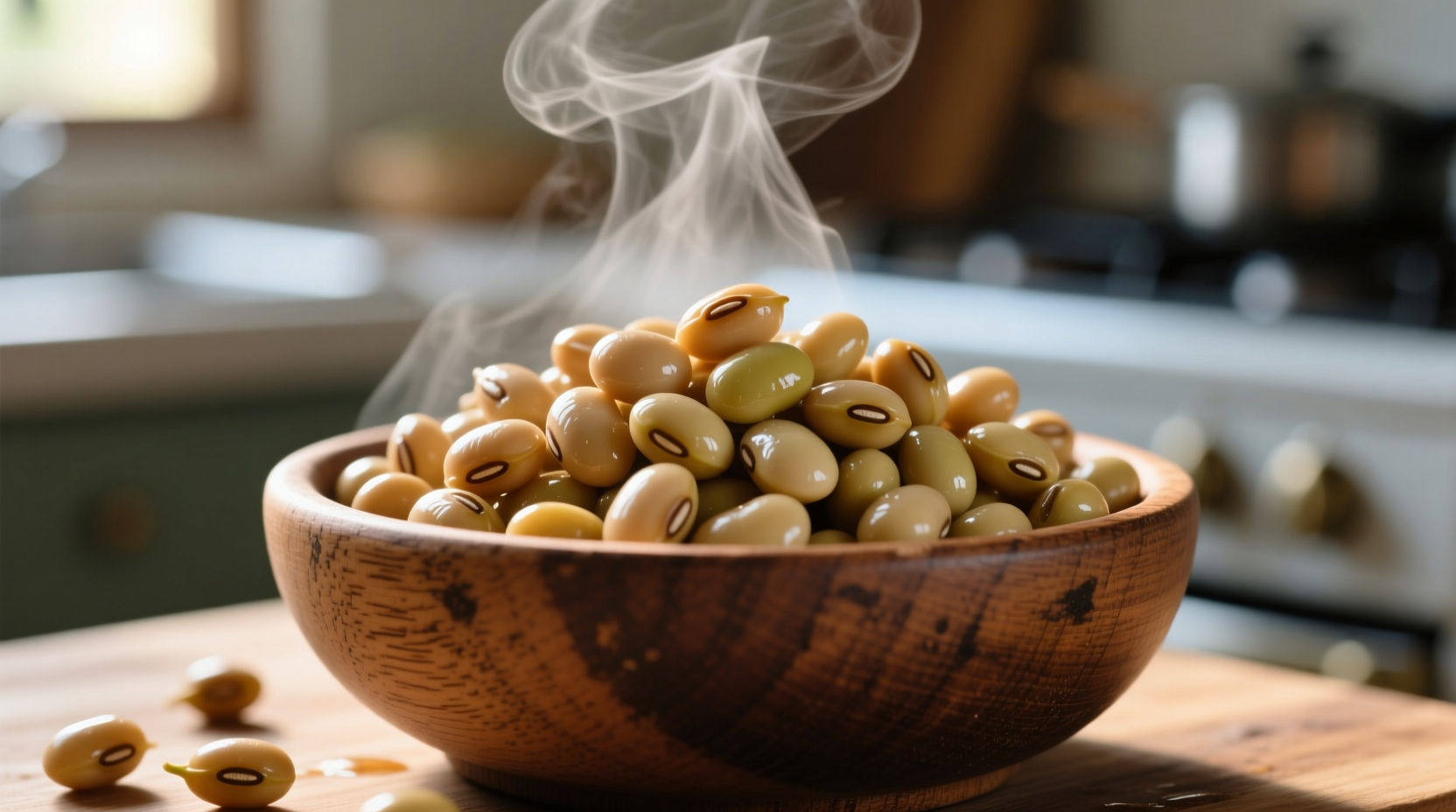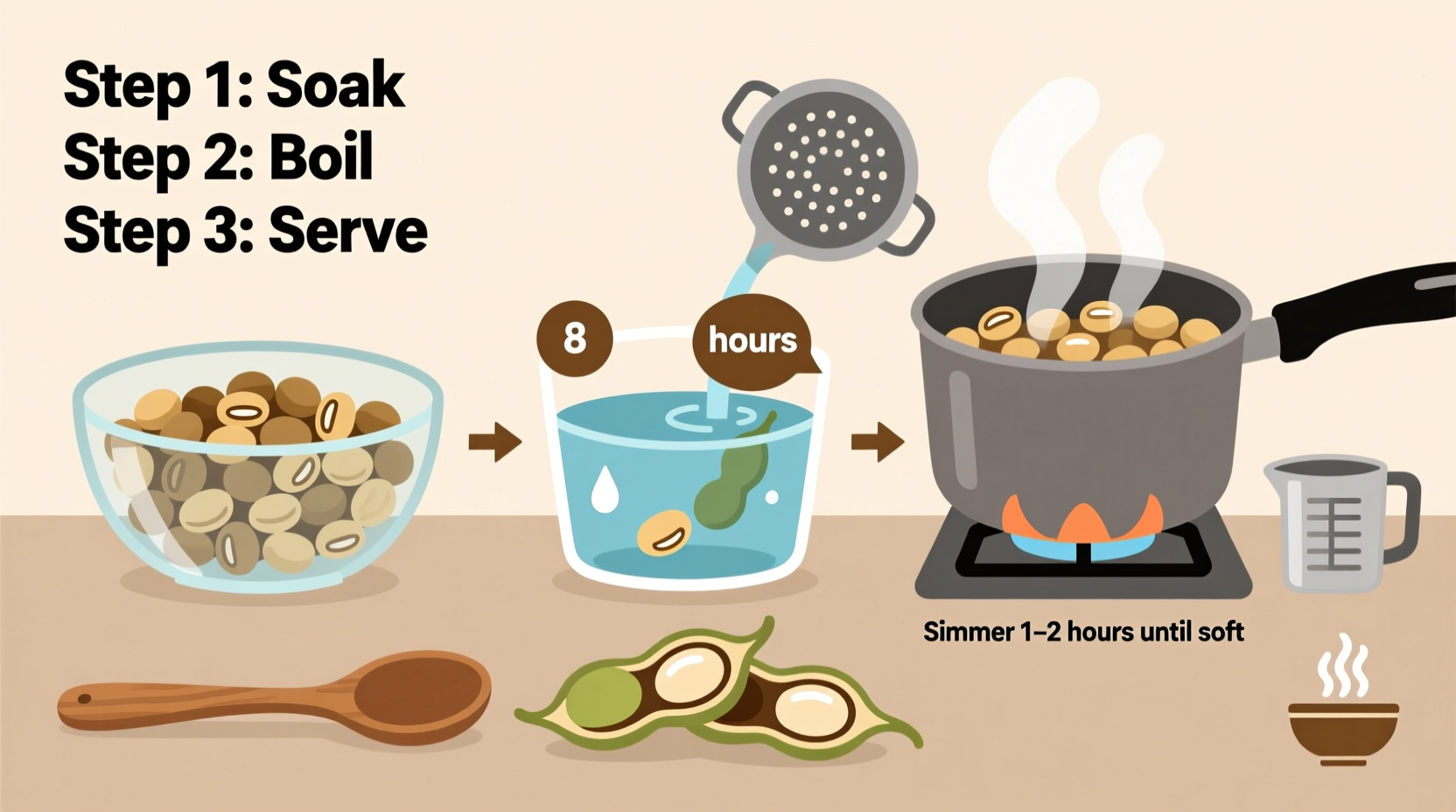Discover the perfect method to cook soybeans that yields creamy, tender results every time. Whether you're preparing them for edamame, tofu, or adding to soups and salads, mastering soybean preparation unlocks their full nutritional potential and delicious flavor.
Why Proper Soybean Cooking Matters
Soybeans contain natural compounds that can cause digestive discomfort when improperly prepared. According to the U.S. Food and Drug Administration, thorough cooking destroys trypsin inhibitors and lectins that interfere with protein digestion. Properly cooked soybeans become more digestible while preserving their impressive nutritional profile—packed with 29g protein, 10g fiber, and essential minerals per cooked cup.
Essential Preparation: The Soaking Process
Skipping soaking adds hours to your cooking time and yields uneven results. Here's how to prepare soybeans correctly:
- Standard soaking: Cover dried soybeans with 3 inches of cold water and soak 8-12 hours at room temperature
- Quick soak method: Boil beans for 2 minutes, remove from heat, cover and soak 1 hour
- Critical step: Always discard soaking water—it contains water-soluble compounds that cause gas
Pro tip: Add 1 teaspoon baking soda to soaking water for creamier results, especially helpful for older beans. The University of Illinois Extension confirms this technique helps soften bean skins by raising the water's pH level.

Three Reliable Cooking Methods Compared
| Method | Time Required | Water Ratio | Best For |
|---|---|---|---|
| Stovetop | 1.5-3 hours | 3:1 water to beans | Traditional preparation, small batches |
| Pressure Cooker | 25-40 minutes | 2:1 water to beans | Weekly meal prep, time-sensitive cooking |
| Slow Cooker | 6-8 hours | 3:1 water to beans | Overnight cooking, hands-off preparation |
Stovetop Cooking: Step-by-Step
This traditional method gives you complete control over texture:
- Drain and rinse soaked soybeans thoroughly
- Place in large pot with fresh water (3 cups water per 1 cup beans)
- Bring to gentle boil, then reduce to simmer
- Cover partially and cook 1.5-3 hours, stirring occasionally
- Add 1 teaspoon salt during last 30 minutes of cooking
- Test for doneness: beans should mash easily between fingers
For perfectly tender soybeans, the USDA National Nutrient Database recommends maintaining a gentle simmer rather than vigorous boiling, which can cause beans to split. Cooking time varies based on bean age and variety—older beans require longer cooking.
Pressure Cooker Method: Fast and Foolproof
Modern appliances dramatically reduce cooking time while improving texture:
- Use 2 cups fresh water per 1 cup soaked soybeans
- Add beans and water to pressure cooker
- Seal lid and bring to high pressure
- Cook for 25 minutes (new beans) or 35-40 minutes (older beans)
- Allow natural pressure release for 15 minutes before quick release
- Add salt after cooking to prevent toughening
Food science research shows pressure cooking at 15 psi (pounds per square inch) achieves the ideal 246°F internal temperature that optimally breaks down soybean oligosaccharides responsible for digestive issues, according to the Journal of Food Science.
Troubleshooting Common Soybean Problems
Even experienced cooks encounter these issues—here's how to fix them:
- Hard beans after cooking: Add 1/4 teaspoon baking soda to cooking water and continue simmering. Older beans often need this boost.
- Split or mushy beans: You likely boiled too vigorously. Maintain a gentle simmer with occasional stirring.
- Insufficient flavor absorption: Add seasonings during the last 30 minutes of cooking—soybeans have dense structure that resists early flavor penetration.
- Excessive foam: Skim foam during first 10 minutes of cooking—it contains impurities that affect texture.
Flavor Enhancements and Serving Suggestions
Elevate your cooked soybeans with these chef-approved techniques:
- Add kombu seaweed during cooking for umami depth and improved digestibility
- Toss warm beans with toasted sesame oil, rice vinegar, and scallions for instant edamame-style dish
- Marinate cooled beans in miso paste, garlic, and ginger for 30 minutes before serving
- Use in place of chickpeas for protein-packed hummus alternative
Storage Guidelines for Perfect Results Every Time
Proper storage maintains texture and prevents spoilage:
- Refrigeration: Store in cooking liquid for up to 5 days—liquid prevents drying
- Freezing: Freeze in 1-cup portions with 1/2 cup cooking liquid for up to 6 months
- Reheating: Simmer frozen beans 5-7 minutes; refrigerated beans need 3-5 minutes
- Never leave cooked soybeans at room temperature longer than 2 hours
When freezing, the National Center for Home Food Preservation recommends labeling containers with cooking date—frozen soybeans maintain best quality for 3 months, though safe for up to 6.
Frequently Asked Questions
Can I cook soybeans without soaking them?
Yes, but unsoaked soybeans require significantly longer cooking—4-6 hours on stovetop. Soaking reduces cooking time by 30-50% and improves digestibility by removing oligosaccharides that cause gas. For pressure cooking unsoaked beans, increase water ratio to 3:1 and cooking time to 45-55 minutes.
Why do my cooked soybeans remain hard despite long cooking?
Hard beans usually indicate either very old beans, hard water, or acidic ingredients added too early. Try adding 1/8 teaspoon baking soda to cooking water (not soaking water) to soften beans. Avoid adding tomatoes, vinegar, or wine until beans are fully tender, as acidity prevents softening.
How can I reduce gas caused by eating soybeans?
Discard soaking water, use the quick soak method, and add kombu seaweed during cooking. The University of Michigan Health System recommends chewing soybeans thoroughly and starting with small portions to allow your digestive system to adjust. Proper cooking destroys 90% of the oligosaccharides responsible for digestive discomfort.
What's the difference between cooking soybeans and other beans?
Soybeans require longer cooking than most legumes due to their dense structure and higher protein content. Unlike kidney beans that need boiling to destroy toxins, soybeans primarily need thorough cooking for digestibility. Soybeans also contain more natural oils, so they're less prone to splitting but more likely to create foam during cooking.
Can I use canned soybeans instead of cooking dried ones?
Canned soybeans offer convenience but often contain added sodium and may have softer texture. For best results, drain and rinse canned beans thoroughly. Cooking dried soybeans gives you complete control over texture and sodium content. Dried beans are typically more economical and environmentally friendly with less packaging waste.











 浙公网安备
33010002000092号
浙公网安备
33010002000092号 浙B2-20120091-4
浙B2-20120091-4